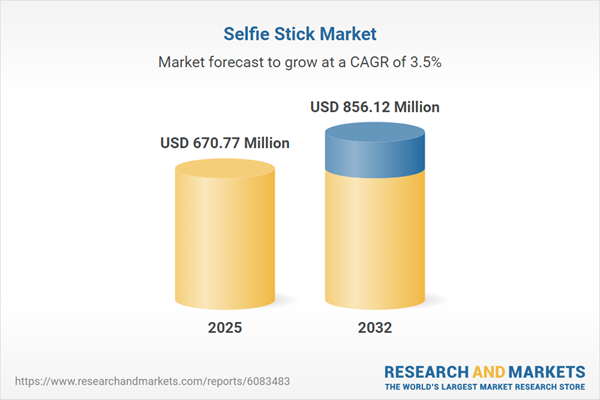Speak directly to the analyst to clarify any post sales queries you may have.
The selfie stick market continues to evolve rapidly, driven by shifting consumer demands and ongoing innovation in personal imaging accessories. This research report offers a comprehensive analysis for senior decision-makers seeking actionable insights into market opportunities, strategic shifts, and competitive positioning.
Market Snapshot: Growth and Trajectory
The selfie stick market grew from USD 648.22 million in 2024 to USD 670.77 million in 2025 and is projected to reach USD 856.12 million by 2032, with a CAGR of 3.53%. Market expansion is supported by emerging consumer trends, product enhancements, and wider adoption across diverse user groups.
Scope & Segmentation
- Product Types: Fixed length selfie sticks; Telescopic selfie sticks
- Material Types: Aluminum; Hybrid; Plastic constructions
- Applications: Personal use; Professional photography
- Distribution Channels: Department stores; E-commerce websites; Mobile apps; Camera shops; Electronics stores
- End Users: Individual consumers; Professional clients
- Regional Markets:
- Americas: United States, Canada, Mexico, Brazil, Argentina, Chile, Colombia, Peru
- Europe, Middle East & Africa: United Kingdom, Germany, France, Russia, Italy, Spain, Netherlands, Sweden, Poland, Switzerland, United Arab Emirates, Saudi Arabia, Qatar, Turkey, Israel, South Africa, Nigeria, Egypt, Kenya
- Asia-Pacific: China, India, Japan, Australia, South Korea, Indonesia, Thailand, Malaysia, Singapore, Taiwan
- Key Companies: Anker Technology Co., Ltd.; MPOW Technology Co., Ltd.; Xiaomi Corporation; DJI Technology Co., Ltd.; Insta360; BlitzWolf; Joby (Vitec Group); Fugetek; UBeesize; Yoozon
Key Takeaways for Senior Decision-Makers
- Innovation has expanded the role of selfie sticks beyond basic accessories, integrating Bluetooth, modular attachments, and professional-grade features for both personal and professional use.
- Material choices—especially advancements in aluminum alloys and hybrid composites—enable manufacturers to balance durability, portability, and cost-effectiveness to align with distinct user segments.
- Growing sustainability concerns are prompting the adoption of recyclable plastics and eco-friendly manufacturing, increasing brand appeal for environmentally aware buyers.
- Specialized models with enhanced grips, LED lighting, and smart connectivity have become essential tools for content creators, social media influencers, and professional photographers.
- Distribution strategies that blend omnichannel approaches, such as experiential retail and online campaigns, are optimizing reach across regional markets with varying preferences and digital adoption rates.
- Competitive dynamics are shaped by established imaging brands, consumer electronics disruptors, and niche specialists, each leveraging targeted partnerships, unique designs, and customized marketing to capture share.
Tariff Impact and Supply Chain Adjustment
The recent escalation of import tariffs on consumer electronics in the United States has prompted strategic shifts throughout the selfie stick supply chain. Manufacturers are adopting reshoring, nearshoring, and regional partnerships to mitigate cost impacts, adapt inventory management, and safeguard operational efficiency. These adjustments are fostering greater supply chain resilience amidst changing global trade dynamics.
Methodology & Data Sources
This report integrates extensive secondary research, including industry publications and regulatory filings, with primary data gathered from manufacturer interviews, distributor feedback, and user focus groups. Quantitative insights are supported by aggregated sales analytics, proprietary surveys, and expert review panels to ensure coverage of technology evolutions and market drivers within the selfie stick industry.
Why This Report Matters
- Enables decision-makers to align product and market strategies with evolving technology, segment shifts, and regional trends in the selfie stick market.
- Provides a holistic view of supply chain adaptability, innovative partnerships, and sustainability considerations, helping organizations identify risk mitigation and growth opportunities.
- Supports corporate planning and investment decisions with actionable consumer insights and an in-depth evaluation of emerging distribution channels.
Conclusion
The selfie stick market reflects a convergence of consumer expectations, technological advancements, and regulatory influence. Success for stakeholders will rely on adaptability, insight-driven action, and disciplined execution to maintain a competitive edge in this dynamic sector.
Table of Contents
3. Executive Summary
4. Market Overview
7. Cumulative Impact of Artificial Intelligence 2025
Companies Mentioned
The companies profiled in this Selfie Stick market report include:- Anker Technology Co., Ltd.
- MPOW Technology Co., Ltd.
- Xiaomi Corporation
- DJI Technology Co., Ltd.
- Insta360
- BlitzWolf
- Joby (a brand of Vitec Group)
- Fugetek
- UBeesize
- Yoozon
Table Information
| Report Attribute | Details |
|---|---|
| No. of Pages | 190 |
| Published | November 2025 |
| Forecast Period | 2025 - 2032 |
| Estimated Market Value ( USD | $ 670.77 Million |
| Forecasted Market Value ( USD | $ 856.12 Million |
| Compound Annual Growth Rate | 3.5% |
| Regions Covered | Global |
| No. of Companies Mentioned | 11 |









